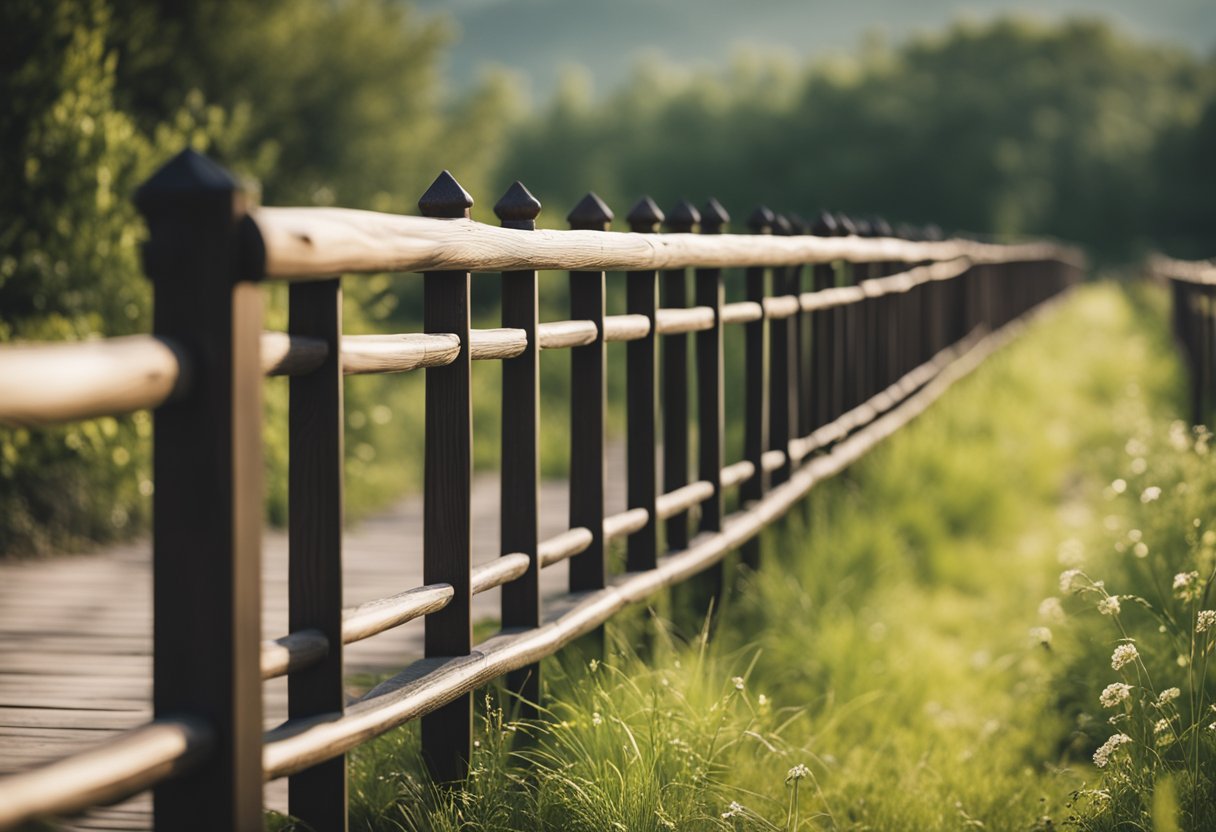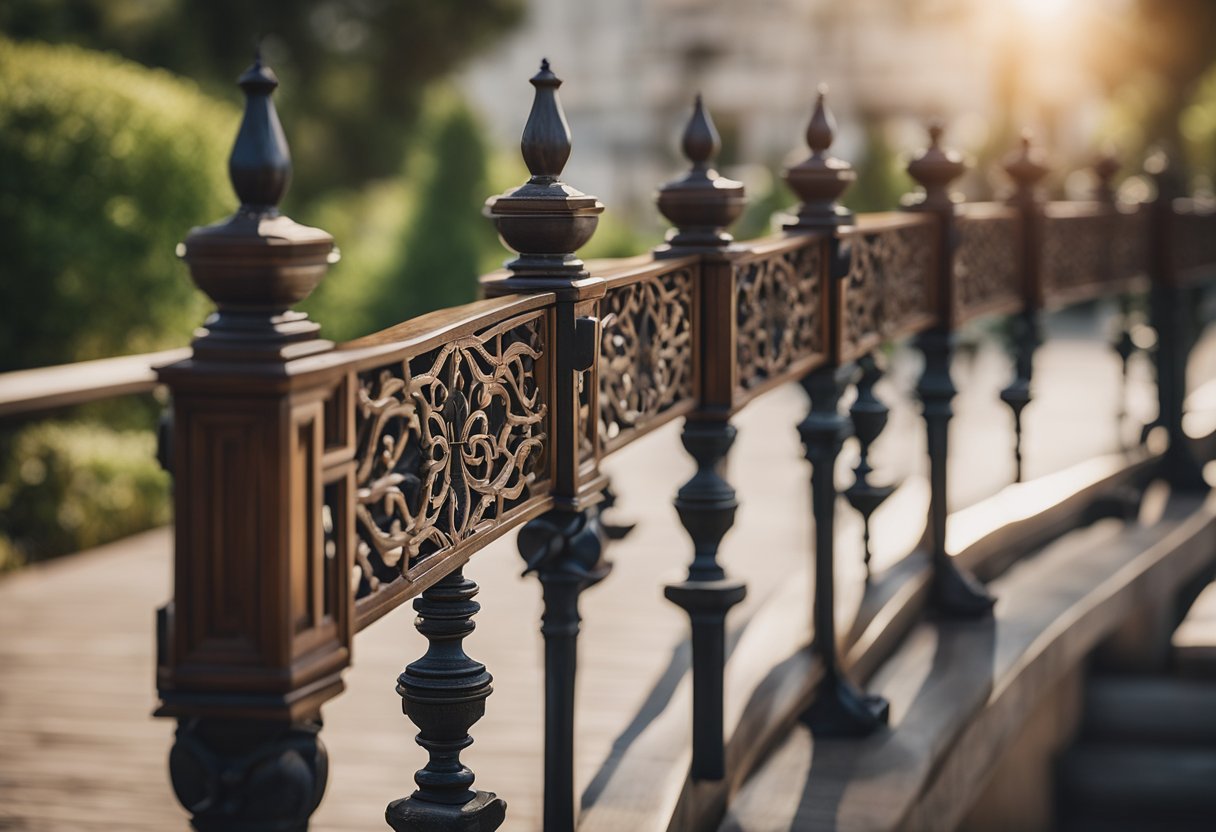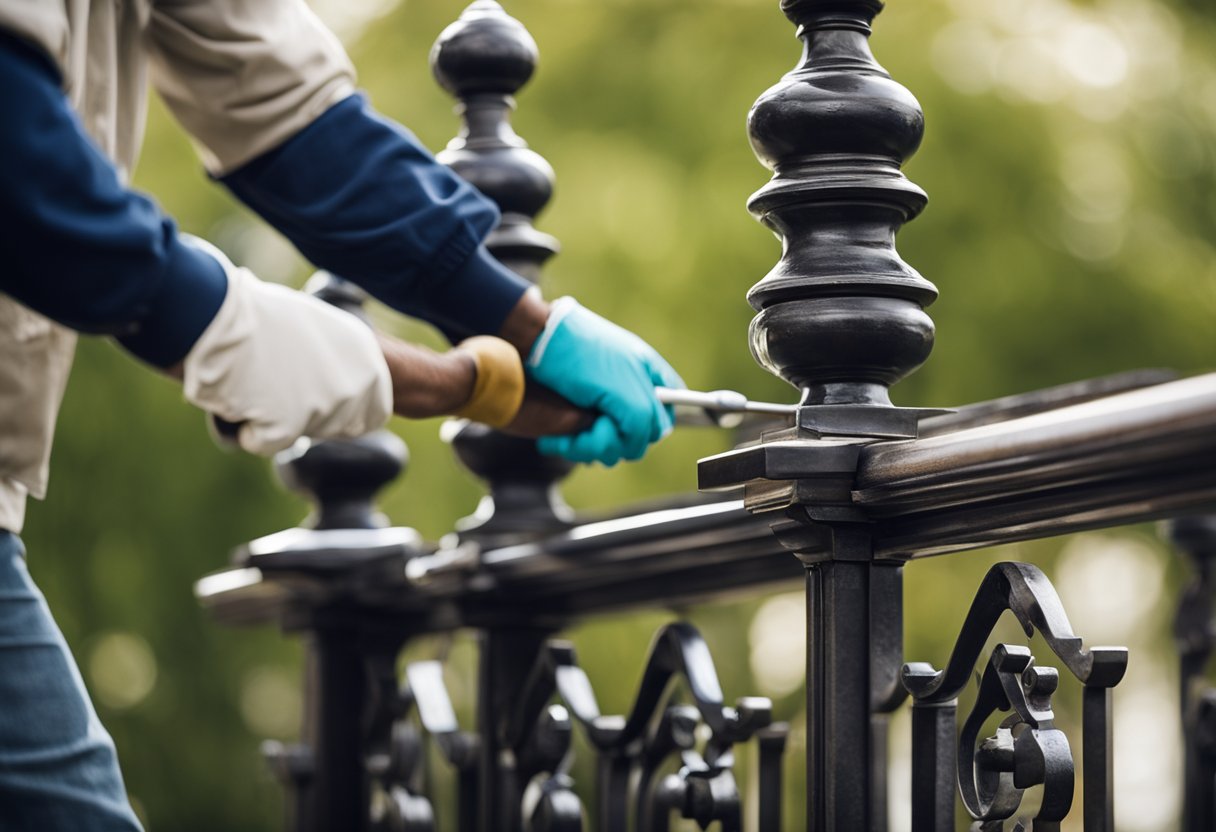Wood and iron railing is a classic design element that can add both beauty and functionality to any home or commercial space. Wood and iron railings are often used for staircases, balconies, decks, and porches. They are a popular choice because they can be customized to fit any style or design aesthetic.
Understanding Wood and Iron Railings
Wood and iron railings are typically made up of several components, including the handrail, balusters, newels, and posts. The handrail is the top component that runs along the length of the railing and provides support for those using the stairs or walking on the balcony. Balusters are vertical posts that support the handrail and provide safety. Newels are the larger posts at the beginning and end of the railing, while posts are the vertical supports that hold up the railing.
The Aesthetics of Wood and Iron Railings
One of the main benefits of wood and iron railings is their aesthetic appeal. They can be customized to fit any style, from traditional to modern. Wood and iron railings can be stained or painted to match the color scheme of the room or outdoor space. The combination of wood and iron also provides a unique texture and contrast that can add visual interest to any area.
Key Takeaways
- Wood and iron railings are a classic design element that can add both beauty and functionality to any space.
- Wood and iron railings are made up of several components, including the handrail, balusters, newels, and posts.
- Wood and iron railings can be customized to fit any style and provide a unique texture and contrast that can add visual interest to any area.
Understanding Wood and Iron Railings
https://www.youtube.com/watch?v=SV0XQxEi7tM&embed=true
When it comes to selecting a railing for your home, there are two primary options: wood and iron. Both materials have their own unique advantages and disadvantages, and it’s important to understand the differences between the two before making a decision.
Wood Railings
Wood railings are a popular choice for many homeowners due to their natural beauty and affordability. They come in a variety of wood species, including cedar, redwood, and pressure-treated pine. Wood railings can be stained or painted to match the color of your home, and they are relatively easy to install.
One of the main drawbacks of wood railings is that they require regular maintenance to keep them looking their best. They are susceptible to rot, insects, and weather damage, so they need to be sealed or painted every few years to prevent decay. Wood railings can also be less sturdy than iron railings, as they may warp or split over time.
Wrought Iron Railings
Wrought iron railings are a more durable and long-lasting option than wood railings. They are made from a combination of iron and carbon, which makes them resistant to rust and corrosion. Wrought iron railings are also very strong and can support heavy loads without bending or breaking.
One of the downsides of wrought iron railings is that they can be more expensive than wood railings. They also require more maintenance than wood railings, as they need to be painted or coated to prevent rust. However, if properly maintained, wrought iron railings can last for decades.
In summary, both wood and iron railings have their own advantages and disadvantages. Wood railings are affordable and easy to install, but require more maintenance than iron railings. Wrought iron railings are more durable and long-lasting, but can be more expensive and require more maintenance. Ultimately, the decision between wood and iron railings will depend on your personal preferences and budget.
Components of Wood and Iron Railings
As a professional in the field of home improvement, I have seen many different types of stair railings. Wood and iron railings are among the most popular choices for homeowners. They are not only stylish but also durable and offer great value for money. In this section, I will discuss the components of wood and iron railings.
Balusters and Newel Posts
Balusters and newel posts are the two main components of railings. Balusters are vertical posts that support the handrail, while newel posts are the larger posts that anchor the railing to the floor. Wood balusters are a popular choice for homeowners who prefer a traditional look, while iron spindles or wrought iron balusters are ideal for those who want a more modern or contemporary look. Doweled tops are used to attach the balusters to the handrail, while baluster shoes are used to attach them to the floor.
Banisters and Handrails
Banisters and handrails are the horizontal components of railings. The banister is the top rail of the railing, while the handrail is the part that people hold onto as they climb the stairs. Wood handrails are a popular choice for those who prefer a warm, natural look, while iron handrails are ideal for those who want a more modern or industrial look. The handrail is attached to the balusters using a variety of different methods, including doweled tops, brackets, and screws.
Stair Treads
Stair treads are the horizontal surfaces that people step on as they climb the stairs. They are available in a variety of different materials, including wood, carpet, and tile. Wood treads are a popular choice for those who prefer a traditional look, while carpet treads are ideal for those who want a softer, more comfortable surface. Tile treads are perfect for those who want a durable, low-maintenance surface.
In conclusion, wood and iron railings are popular choices for homeowners who want a stylish, durable, and valuable addition to their homes. Balusters and newel posts, banisters and handrails, and stair treads are the main components of railings. Homeowners can choose from a variety of different materials and styles to create the perfect look for their home.
The Aesthetics of Wood and Iron Railings
https://www.youtube.com/watch?v=UmwSEg-y6do&embed=true
As an expert in staircase design, I have always been fascinated by the aesthetics of railings. Wood and iron are two of the most popular materials used in balustrade design, and each has its own unique beauty.
Wooden railings have a classic and timeless feel that can add warmth and coziness to any space. They are available in a variety of finishes and can be stained or painted to match the surrounding decor. However, wooden railings require regular maintenance and may not be suitable for outdoor use in areas with extreme weather conditions.
On the other hand, wrought iron balustrades have a distinctive and elegant look that can complement both modern and traditional interior design styles. They are durable and require minimal maintenance, making them ideal for high-traffic areas. Wrought iron balustrades are also available in a variety of styles and finishes, including black, bronze, and white.
When it comes to combining wood and iron in a railing design, the possibilities are endless. A wooden handrail with wrought iron balusters can create a stunning contrast that adds visual interest to a staircase. Alternatively, an all-wood railing with wrought iron accents can create a rustic and charming feel.
In conclusion, the aesthetics of wood and iron railings are both beautiful in their own way. Whether you prefer the warmth of wood or the elegance of wrought iron, there is a railing design that can enhance the beauty of your staircase.
Installation of Wood and Iron Railings
https://www.youtube.com/watch?v=TsqKJuSng8k&embed=true
When it comes to installing wood and iron railings, there are a few important steps to follow to ensure a safe and secure installation. In this section, I will cover the main steps involved in the installation process.
Pre-Drilling and Screwing
One of the most important steps in the installation process is pre-drilling and screwing the wood and iron components together. This is especially important when installing the handrail to the newel post and when securing the balusters to the handrail and shoe rail.
To pre-drill the holes, I recommend using a drill bit that is slightly smaller than the diameter of the screws you will be using. This will ensure that the wood and iron do not split when the screws are inserted.
Once the holes are drilled, you can then insert the screws to secure the components together. It is important to use screws that are long enough to provide a secure hold, but not so long that they penetrate through the other side of the wood or iron.
In addition to pre-drilling and screwing, it is also important to ensure that the staircase is level and that all components are properly aligned before securing them in place. This will help to ensure that the railing is safe and secure for use.
Overall, the installation process for wood and iron railings requires careful attention to detail and a focus on safety. By following the steps outlined above, you can ensure a successful installation that will provide years of safe and secure use.
Maintenance of Wood and Iron Railings
Maintaining wood and iron railings is crucial to ensure their longevity and keep them looking their best. Here are some tips on how to maintain your wood and iron railings.
Wood Railings
Wood railings require regular maintenance to prevent damage from the elements. Here are some steps to follow:
-
Clean the railings regularly. Use a soft-bristled brush or a cloth to remove dirt and debris from the surface of the railings. Avoid using harsh chemicals or abrasive cleaners, as they can damage the wood.
-
Stain the railings. Apply a wood stain to the railings to protect them from moisture, UV rays, and other environmental factors. Choose a stain that is specifically designed for outdoor use and matches the color of your existing railings.
-
Inspect the railings for damage. Check the railings periodically for signs of damage, such as cracks, splits, or rot. Repair any damage as soon as possible to prevent it from spreading.
Iron Railings
Iron railings are durable and long-lasting, but they still require regular maintenance to prevent rust and other damage. Here are some steps to follow:
-
Clean the railings regularly. Use a soft-bristled brush or a cloth to remove dirt and debris from the surface of the railings. If the railings are particularly dirty, you can use a mild detergent to clean them.
-
Inspect the railings for rust. Check the railings periodically for signs of rust, such as reddish-brown spots or flaking paint. If you notice any rust, use a wire brush to remove it and then apply a rust inhibitor to prevent it from coming back.
-
Repaint the railings. Over time, the paint on iron railings can become chipped or faded. To keep your railings looking their best, repaint them every few years. Choose a paint that is specifically designed for metal surfaces and matches the color of your existing railings.
By following these simple maintenance tips, you can keep your wood and iron railings looking great for years to come.
Choosing Between Wood and Iron Railings
https://www.youtube.com/watch?v=bnIcgFxIqXo&embed=true
When it comes to choosing the right railing for your home, you have two major options to consider: wood or iron. Each material has its own unique features and benefits, and the choice ultimately depends on your personal preferences and needs.
Wood Railings
Wood railings are a popular choice for many homeowners due to their natural beauty and warmth. They can be stained or painted to match the color scheme of your home and can be designed in a variety of styles to fit your aesthetic preferences.
One of the main advantages of wood railings is their affordability. They are generally less expensive than iron railings, making them a great option for those on a tight budget. However, it is important to note that wood railings require more maintenance than iron railings. They need to be regularly cleaned, sanded, and refinished to prevent rot and decay.
Wrought Iron Railings
Wrought iron railings are known for their durability and strength. They are resistant to weathering, rust, and corrosion, making them a great option for outdoor use. They can also be designed in a variety of styles, from simple and elegant to intricate and ornate.
One of the main advantages of wrought iron railings is their low maintenance needs. They require minimal upkeep and can last for decades with proper care. However, they are generally more expensive than wood railings, making them a less budget-friendly option.
In summary, both wood and iron railings have their own unique advantages and disadvantages. When choosing between the two, consider factors such as your budget, maintenance needs, and aesthetic preferences. Ultimately, the choice comes down to what works best for you and your home.
Frequently Asked Questions
https://www.youtube.com/watch?v=7NcNX_MrTaA&embed=true
What are some popular designs for wood and iron railings?
Wood and iron railings are a popular choice for homeowners who want to add a touch of elegance to their home’s interior or exterior. Some popular designs for wood and iron railings include traditional, contemporary, and rustic styles. Traditional designs often feature ornate iron balusters and carved wooden handrails, while contemporary designs tend to be sleek and minimalist. Rustic designs often incorporate natural wood elements, such as tree branches or reclaimed wood.
What are the benefits of using iron balusters in a railing design?
Iron balusters are a popular choice for railing designs because they are durable, low-maintenance, and come in a variety of styles. They can be used to create intricate patterns and designs, or they can be used to add a simple, elegant touch to a railing. Iron balusters are also resistant to corrosion and can withstand extreme temperatures, making them a great choice for outdoor railings.
What are some modern wooden railing designs for stairs?
Modern wooden railing designs for stairs often feature clean lines, simple shapes, and natural finishes. Some popular modern wooden railing designs include cable railings, glass railings, and floating staircases. These designs can be customized to fit any style or decor, and they can be made from a variety of wood species, including oak, maple, and cherry.
Is wrought iron railing more durable than wood?
Wrought iron railing is generally more durable than wood railing. Iron is resistant to corrosion and can withstand extreme temperatures, making it a great choice for outdoor railings. Wood, on the other hand, is susceptible to rot, decay, and insect damage if not properly maintained. While wood railing can last for many years with proper care, wrought iron railing is generally considered to be a more durable and low-maintenance option.
Which is more cost-effective, wrought iron or wooden railing?
The cost of a wood and iron railing will depend on a variety of factors, including the size of the project, the materials used, and the complexity of the design. In general, wooden railing is less expensive than wrought iron railing. However, wrought iron railing is more durable and requires less maintenance over time, which can make it a more cost-effective option in the long run.
Are iron balusters still a popular choice for railing designs?
Iron balusters are still a popular choice for railing designs, thanks to their durability, low-maintenance, and wide range of styles. They can be used to create intricate patterns and designs, or they can be used to add a simple, elegant touch to a railing. Iron balusters can also be painted or powder-coated to match any decor, making them a versatile choice for any home.

Hi, I’m Sal Muller of Tooltrip.com. My DIY experience led me to understand essential power tools for home projects. Tooltrip.com guides enthusiasts and professionals in choosing right tools for any job. I provide concise top tool reviews for easier, efficient DIY.




